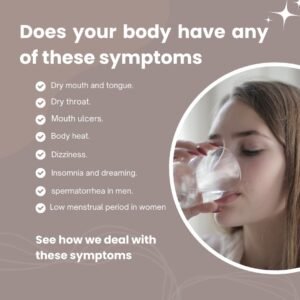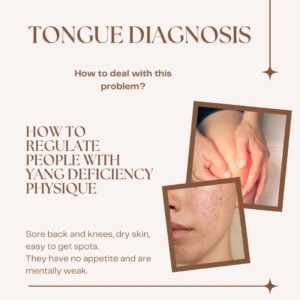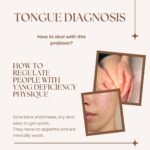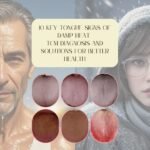TCM Tongue Diagnosis is a vital diagnostic tool in Traditional Chinese Medicine (TCM). By examining the tongue coating, TCM practitioners can gain valuable insights into a person’s overall health. The tongue coating refers to the layer of substance that forms on the surface of the tongue. A healthy tongue coating is typically white, evenly distributed, and of moderate thickness and moisture, with the middle and root of the tongue being slightly thicker and the rest thinner. The changes in the tongue coating are closely linked to the state of the digestive system and the energy flow in the body, making it an important indicator of the condition of the stomach and spleen.
Examining the Tongue Coating
In TCM Tongue Diagnosis, observing the tongue coating is a crucial step in the diagnostic process. The texture and appearance of the coating, known as the “tongue coating quality,” provides critical information. Key characteristics to examine include the coating’s thickness, moisture level, texture (whether it’s greasy or dry), whether it’s “true” or “false,” any signs of peeling, and its distribution. By closely analyzing these features, TCM Tongue Diagnosis practitioners can assess the nature and progression of various health conditions affecting the body.
Table of Contents
一. Thin and Thick Coating
In Traditional Chinese Medicine (TCM), the thickness of the tongue coating can reflect the severity of a disease. If the coating becomes thicker during the course of an illness, it indicates that the condition is deepening, and the thicker the coating, the more serious the illness. This is often seen in digestive system disorders.
1.Thin Coating – Stomach Yang Deficiency

(Image: Thin coating, visible tongue body)
A thin white coating with a pale red tongue is typically a normal tongue appearance, indicating that the body’s energy and blood are abundant and the internal organs are functioning harmoniously. The stomach is in a state of vitality. However, when the coating becomes excessively thin, or even nearly absent, it suggests that “stomach yang is unable to rise and warm the body, while kidney yin cannot properly nourish the body.”
Tongue Features: When the coating is thin enough that the tongue body is faintly visible, this is called “seeing the bottom” (见底), which signifies a thin coating.
Main Condition: A thin coating is often associated with conditions like stomach yang deficiency and kidney yin deficiency, which are commonly seen in TCM tongue diagnosis.
2. Thick Coating – Gastrointestinal Stagnation

(Image: Thick coating, no visible tongue body)
A thick coating is typically caused by an excess of dampness in the body. This can be related to prolonged exposure to a damp environment, overeating spicy and greasy foods, or consuming cold and raw foods. In these cases, the spleen’s inability to effectively transform and transport moisture leads to the accumulation of dampness on the tongue surface, forming a thick coating.
Tongue Features: When the tongue coating is so thick that the tongue body is completely hidden, this is called “not seeing the bottom” (不见底), which signifies a thick coating.
Main Condition: A thick coating is commonly seen in conditions like stomach qi deficiency and gastrointestinal stagnation, making it a significant diagnostic feature in TCM tongue diagnosis.
二. Moisture and Dryness of the Coating
In Traditional Chinese Medicine (TCM) tongue diagnosis, observing the moisture or dryness of the tongue coating helps assess the body’s fluid balance and distribution. The coating’s moisture level can be categorized into four types: moist coating, slippery coating, dry coating, and rough coating.

1. Moist Coating (润苔)
Tongue Features: A moist coating indicates that the tongue surface is hydrated, with balanced moisture—neither too dry nor too slippery. This is a normal tongue appearance, reflecting that the stomach’s fluids and kidney essence are intact and evenly spread over the tongue surface.
Main Condition: Moist coating is commonly seen in conditions such as early-stage wind-cold, damp conditions, food stagnation, or blood stasis. It suggests that the body’s fluids are intact and undamaged.

2. Slippery Coating (滑苔)
Tongue Features: A slippery coating appears overly moist, with a slick, greasy surface that may even cause excessive salivation, often described as “slippery coating.”
Main Condition: Slippery coating is a sign of internal water and dampness accumulation. It is commonly seen in cases of excessive water intake or an excess of dampness in the body.

3. Dry Coating (燥苔)
Tongue Features: A dry coating lacks moisture, and the tongue may feel parched. In severe cases, the coating may crack and appear flaky.
Main Condition: Dry coating typically indicates a depletion of body fluids or an obstruction in fluid distribution, often seen in conditions of excessive internal heat or yin deficiency.

4. Rough Coating (糙苔)
Tongue Features: A rough coating appears dry, coarse, and may feel obstructive to the touch, with a harsh texture.
Main Condition: Rough coating is an advanced form of dry coating and usually signals excessive heat injuring body fluids. The tongue body may also appear dry in such cases.
三. Thick and Greasy Coating
In TCM tongue diagnosis, observing the presence of thick and greasy coating is essential for understanding the changes in yang energy and the accumulation of dampness. A thick coating often indicates heat-related conditions, while a greasy coating is commonly seen in cases of excessive dampness, phlegm accumulation, and stagnation of yang energy.

1. Thick Coating (腐苔) – Heat and Food Stagnation
Tongue Features: A thick coating typically results from an excess of yang heat, causing the impure gases from the stomach to rise and accumulate on the tongue surface. This is often seen in conditions where there is food stagnation in the digestive system, internal phlegm dampness, and heat in the stomach and intestines.
Main Condition: The coating appears thick, with coarse, granular particles resembling the texture of tofu curds. It’s easy to scrape off.
Main Condition Indicator: A thick coating is usually associated with food stagnation, phlegm, and internal heat. It’s one of the classic signs of heat-related conditions in TCM tongue diagnosis.

2. Greasy Coating (腻苔) – Phlegm, Dampness, and Food Stagnation
Tongue Features: A greasy coating is typically white or yellow. White indicates internal coldness with an abundance of dampness, while yellow suggests that dampness or phlegm has turned into heat, or that damp-heat has invaded the internal organs. It may also indicate that food stagnation is transforming into heat.
Main Condition: The coating appears smooth and dense, with fine, oily granules that are difficult to scrape off, like a greasy film.
Main Condition Indicator: A greasy coating is commonly found in conditions involving phlegm dampness and food stagnation, and is a sign of excessive moisture or dampness in the body.
四. True vs. False Coating
In Traditional Chinese Medicine (TCM) tongue diagnosis, the coating is classified as either “true” (有根苔) or “false” (无根苔), and the distinction between the two indicates different stages of the disease. The presence of a root indicates “true coating,” while the absence of a root indicates “false coating.”

1. True Coating (有根苔) – Mild Condition
Tongue Features: True coating is firmly attached to the tongue surface and is difficult to scrape off. It appears as if it has grown directly from the tongue. Even if the coating is thick, as long as it is rooted, it typically suggests that the pathogenic factors are not too severe, and the body’s vital energy (正气) is still intact.
Main Condition: True coating is often seen in conditions with excess heat or other “full” syndromes. It indicates that the disease is not too severe, and the body’s defense system is still relatively strong.
Diagnosis Significance: True coating is commonly observed in conditions such as heat syndromes, indicating a mild stage of illness where the body’s qi is still strong.

2. False Coating (无根苔) – Severe Condition
Tongue Features: False coating occurs when the tongue coating has begun to separate from the tongue surface due to insufficient stomach qi. The coating is easily scraped off, revealing a clean tongue surface underneath, indicating a more serious condition.
Main Condition: False coating suggests that the body’s vital energy (正气) is weakened, and the stomach qi is insufficient, making it unable to generate fresh coating. This points to a more serious illness, often in its later stages.
Diagnosis Significance: False coating is typically seen in conditions of deficiency or cold syndromes, indicating that the disease has progressed, and the body’s vitality has been significantly weakened.
五. Desquamated Coating
In TCM tongue diagnosis, desquamated coating refers to the partial or complete shedding of the tongue coating, leaving smooth areas where the tongue’s surface is visible. This type of tongue appearance typically indicates a deficiency of both the stomach qi and yin, causing the stomach qi to fail in rising to the tongue surface, which leads to atrophy of the tongue mucosal epithelium. Desquamated coating is a classic sign of both qi and blood deficiency and is often seen in conditions such as weak stomach qi or depleted stomach yin. Based on the location, extent, and size of the coating loss, it can be further categorized into the following types:

1. Front Desquamated Coating (前剥苔)
Tongue Features: The coating on the front of the tongue is shed, leaving the tip of the tongue smooth.
Main Condition: Front desquamated coating is commonly associated with heart yin deficiency, indicating weakened heart function.

2. Root Desquamated Coating (根剥苔)
Tongue Features: The coating at the root of the tongue is shed, referred to as root desquamated coating or posterior desquamation.
Main Condition: Root desquamated coating typically suggests kidney yin deficiency, reflecting a decline in kidney function and a deficiency of body fluids.

3. Glossy Desquamated Coating (光剥苔) or Mirror Tongue
Tongue Features: The coating is completely gone, leaving the tongue surface smooth like a mirror. Glossy desquamated coating is the most severe form of coating loss.
Main Condition: Glossy desquamated coating is often seen in severe or critical illnesses, particularly when the stomach qi is severely damaged, indicating a very serious condition.

4. Middle Desquamated Coating (中剥苔)
Tongue Features: The coating in the middle of the tongue is shed, leaving the center of the tongue smooth.
Main Condition: Middle desquamated coating is generally associated with stomach qi deficiency, stomach yin depletion, or qi and blood deficiency, reflecting a weakness in the digestive system.

5. Pseudo-Desquamated Coating (类剥苔)
Tongue Features: The areas where the coating has shed still show some new coating particles or papillae, making the surface not fully smooth.
Main Condition: Pseudo-desquamated coating is commonly seen in qi and blood deficiency conditions, indicating a reduced ability of the body to recover and insufficient qi and blood circulation.

6. Map-like Desquamated Coating (花剥苔)
Tongue Features: The coating is shed in multiple, irregular patches, leaving smooth areas that resemble a map, with only a small amount of coating remaining.
Main Condition: Map-like desquamated coating often indicates damage to both stomach qi and yin, suggesting significant dysfunction in the digestive system and more severe depletion of vital energy.
By analyzing desquamated coating in TCM tongue diagnosis, healthcare practitioners can gather important clinical information. The types of desquamated coating are closely related to the severity of the disease and the specific condition of the patient. This technique plays a critical role in accurately diagnosing health issues, especially in cases involving digestive and internal organ dysfunctions.
六. Partial and Full Coating
In TCM tongue diagnosis, the distribution of the tongue coating plays a crucial role in identifying the location and nature of a disease. The terms partial coating (偏苔) and full coating (全苔) refer to how the coating is distributed across the tongue’s surface, and this distribution can help diagnose the specific areas of the body affected by illness.
- Full Coating generally indicates that pathogenic factors are widespread throughout the body, while partial coating suggests that the pathogen is concentrated in a specific region, often closely linked to an imbalance in a particular organ or system.

1. Partial Coating (偏苔) – Pathogens Accumulated in a Specific Area
Tongue Features: Partial coating appears in specific areas of the tongue – the front, back, left, or right side. In this condition, the coating is thick and concentrated in one region, while other areas may either have no coating or a thinner coating.
Main Condition: Partial coating usually indicates that pathogens are localized in a particular organ. For instance:
- If the coating is concentrated at the tongue’s tip, it may signal damage to the stomach qi, but not yet deep penetration.
- If the coating is found at the root of the tongue, this might suggest a retreat of internal pathogens, but with stagnation in the stomach.
- When the coating is limited to the middle of the tongue, it could relate to phlegm retention or food stagnation.
- If partial coating is found on both sides of the tongue, it may reflect liver and gallbladder damp-heat, or a condition at the boundary between the body’s interior and exterior.

2. Full Coating (全苔) – Dampness and Phlegm Obstruction
Tongue Features: Full coating refers to a thick, uniform layer covering the entire tongue surface, without noticeable regional differences in thickness. The coating is evenly distributed across the tongue.
Main Condition: Full coating is typically associated with conditions of dampness and phlegm obstruction, where pathogenic factors have spread throughout the body. This pattern suggests that both dampness and phlegm have accumulated in the body, hindering the normal function of internal organs. Full coating is commonly seen in patients with spleen deficiency or excessive dampness, indicating weak vitality and significant internal stagnation.
Through careful observation of the partial and full distribution of the tongue coating, TCM practitioners can pinpoint the accumulation of pathogens and the obstruction of dampness and phlegm in the body. This diagnostic technique is invaluable in identifying both the location and the severity of organ imbalances, offering valuable insights into the patient’s health and aiding in the formulation of an appropriate treatment plan.
Summary:
Through an in-depth analysis of TCM tongue diagnosis, we can see the crucial role that tongue coating plays in reflecting the health status of the body. Characteristics such as the thickness, moisture, texture, and nature of the coating, including whether it is genuine, peeled, or partial, provide valuable diagnostic information for TCM practitioners. Each change in the tongue coating corresponds to different pathological conditions, helping to identify the nature and progression of diseases. For example, a thin coating may indicate stomach yang deficiency, while a thick coating is often related to intestinal stagnation. Coatings with dampness or greasy textures, such as moist or rough coatings, signal internal dampness, phlegm, or fluid imbalances.
In clinical practice, the meticulous observation and analysis of tongue coatings offer strong support for TCM treatments and serve as a critical reference for health management. By mastering and applying TCM tongue diagnosis techniques, practitioners can more accurately assess a patient’s condition and tailor treatment plans that are better suited to the individual’s unique needs.
More Articles in “Identification Tongue”:
- Tongue Sensation & Taste
- Tongue Shape
- Tongue Color
- Tongue Condition
- Tongue Coating








